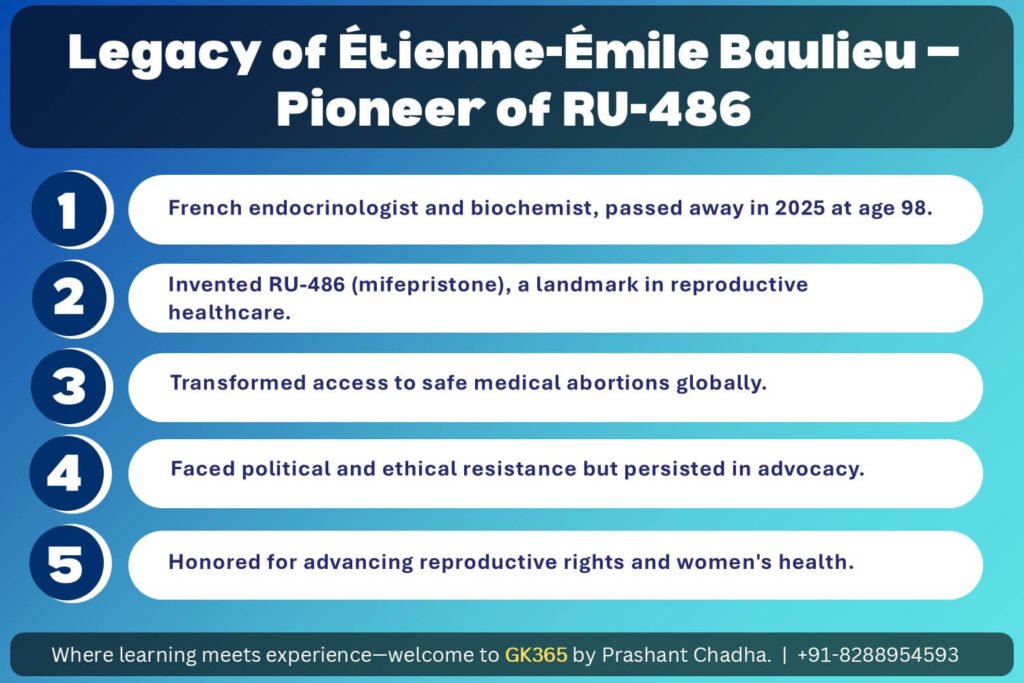Introduction
Étienne-Émile Baulieu, the French biochemist who created the abortion pill RU-486 (mifepristone), died on May 31, 2025. He was 98. Known for his research on steroid hormones, Baulieu also worked on aging and brain diseases. His invention changed abortion access worldwide and shaped debates in science, law, and medicine.
Baulieu was more than a scientist. His work connected biology to personal freedom and public health.
📑 Table of Contents
- Who Was Étienne-Émile Baulieu?
- Invention of RU-486 (Mifepristone)
- Impact on Global Reproductive Rights
- Scientific Contributions Beyond RU-486
- Public Advocacy & Societal Influence
- Honors, Awards, and Global Recognition
- Background & Personal Journey
- Legacy and Global Significance
- FAQs About Étienne-Émile Baulieu
- Related Reading & Resources
- Conclusion: Celebrating a Revolutionary Scientist
- Key Takeaways Table
🧠 Who Was Étienne-Émile Baulieu?
Born in Strasbourg, France, in 1926 as Étienne Blum, he changed his name during his time in the French Resistance. He earned a medical degree in 1955 and a Ph.D. in biochemistry in 1963. He joined the French Communist Party in his youth but left it after the Soviet invasion of Hungary in 1956. This decision reflected his independence.
Baulieu rose to national and international scientific leadership and became one of France’s most respected researchers.
💊 Invention of RU-486 (Mifepristone)
In the early 1980s, Baulieu worked with Roussel-Uclaf to develop RU-486. The drug, later called mifepristone, blocks progesterone—a hormone required to maintain pregnancy. It allows early abortions without surgery.
Milestones:
- 1988: Approved in France after early political pushback
- 2000: Approved by the U.S. Food and Drug Administration
- By 2020: Used in over 50% of all U.S. abortions
Baulieu described RU-486 as a “contragestive,” focusing on how it worked rather than on political labels. The drug gave millions of people a safe and simple option for ending early pregnancies.
🌍 Impact on Global Reproductive Rights
Baulieu’s invention reached far beyond medicine. It fueled debates over ethics, religion, and autonomy. Despite intense criticism from religious groups and conservative leaders, Baulieu remained clear in his support of reproductive choice.
His stance helped normalize discussions about abortion and pushed many governments to treat reproductive health as a human right.
🔬 Scientific Contributions Beyond RU-486
🧪 Hormone Research
Baulieu’s career also included major work on steroid hormones like:
- DHEA (Dehydroepiandrosterone)
- Estrogen
- Progesterone
He studied how these hormones affect fertility, puberty, aging, and mental health.
🧠 Focus on Brain Health
Later in life, he turned to brain diseases. He explored progesterone’s possible role in protecting the brain. He also founded the Institut Baulieu, which focuses on aging, memory loss, and Alzheimer’s research.
His findings continue to guide studies in brain health and aging.
📣 Public Advocacy & Societal Influence
Baulieu spoke out clearly and often. He defended mifepristone’s scientific value, even in the face of opposition. He explained its use in public forums and helped frame it as a medical tool, not a moral issue.
He showed that a scientist can also be a public voice—combining facts with principles and public trust.
🏅 Honors, Awards, and Global Recognition
Baulieu’s work earned widespread praise. He served as:
- President of the French Academy of Sciences
- Member of the U.S. National Academy of Sciences
He also received:
- Légion d’honneur (France’s top civilian award)
- UNESCO Gold Medal for Science
- Many honorary degrees and global awards
👨🔬 Background & Personal Journey
- Born: 1926, Strasbourg
- WWII: Joined the French Resistance
- Education: MD (1955), Ph.D. in biochemistry (1963)
- Politics: Left the Communist Party in 1956
- Family: Married to Simone Harari Baulieu, a media executive
His early experience with war and political change shaped his values on autonomy and freedom of thought.
🧭 Legacy and Global Significance
- He redefined reproductive medicine.
- He expanded hormone science and brain research.
- He stood firm when politics challenged science.
Debates over RU-486 still unfold in courts and legislatures. His work remains relevant.
❓FAQs About Étienne-Émile Baulieu
- What is RU-486 (mifepristone), and how does it work?
It blocks progesterone, stopping a pregnancy from continuing. Used with misoprostol, it supports early-stage abortions. - Why was RU-486 controversial?
It challenged many political and religious beliefs. Baulieu’s defense of it sparked ongoing arguments about science, ethics, and rights. - What other research did Baulieu conduct?
He studied DHEA and progesterone and later focused on aging and Alzheimer’s prevention. - Why does Baulieu’s legacy still matter?
His work shapes today’s access to reproductive care and informs new research in brain science. - Was Baulieu active in politics?
He was political in youth but later focused on science. He often spoke against ideology in research.
🔗 Related Reading & Resources
- World Health Organization – Mifepristone Guidelines
- NIH on Progesterone and Brain Health
- Planned Parenthood – Abortion Pill Facts
📢 Conclusion: Celebrating a Revolutionary Scientist
Baulieu reshaped medicine and public health. His ideas and inventions still affect millions. He challenged bias, defended science, and built a legacy that continues to grow.
👉 Visit GK365.in to read more stories about science and ethics.
Key Takeaways Table
| Category | Details |
|---|---|
| Monument Name | Sri Nanak Niwas – India’s first wooden Gurdwara |
| Location | Fazilka, Punjab, within the Fazilka police lines |
| Material Used | Constructed entirely from Finnish Deodhar wood – durable and eco-friendly |
| Inauguration Date | February 16, 2023 |
| Project Lead | SSP Bhupinder Singh Sidhu, Fazilka |
| Architectural Features | – 40 ft. square design with 4 doors (symbolizing Sikh openness)- Domes and arches for natural ventilation- Doors face N & S for airflow |
| Construction Details | – Completed in just 3 months– Wood imported from Finland- Designed and crafted by carpenter Iqbal Singh from Ludhiana |
| Purpose & Vision | A place of worship for police families, designed to reflect Sikh values of inclusiveness and humility with modern sustainable architecture |
| Daily Use & Activities | – Daily recitations (5:30 AM to 8 PM)- Sunday Sangat gatherings- Ceremonies including weddings and kirtans |
| Community & Cultural Role | Enhances Punjab’s religious and architectural heritage; promotes interfaith unity, design innovation, and sustainability |
| Tourism & Impact | Draws both spiritual pilgrims and design enthusiasts; expected to boost religious tourism and local economy |
| Environmental Focus | – Wooden architecture for reduced energy use- Natural cooling and ventilation- Low material waste during construction |



